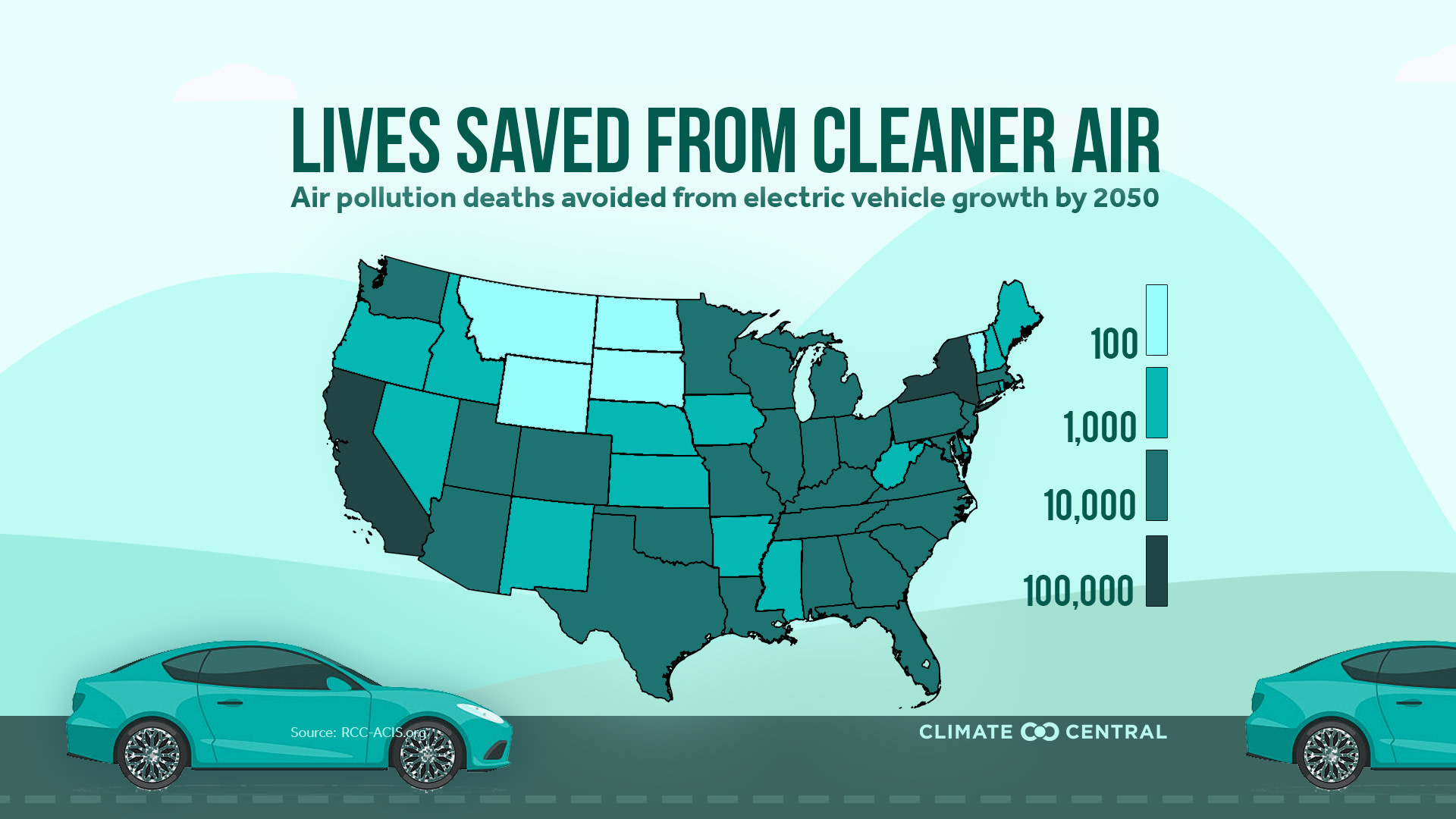KEY CONCEPTS
In the U.S., transportation produces the most greenhouse gas emissions of any sector. Switching from internal combustion vehicles to electric vehicles is therefore an important component of our efforts to combat climate change.
Climate Central’s latest climate solutions brief offers a primer on electric vehicles, and how they can enable us to shrink transportation emissions. To reach the goals of the Paris Climate Agreement, electric vehicles (EVs) will need to make up the majority of vehicle sales by 2030.
Improvements from EV adoption will also improve air quality and health. Princeton researchers found that a transition to electric vehicles could avoid as many as 165,000 deaths by 2050. Most health benefits are concentrated in states with dense urban areas such as California, New York and Florida, and particularly among marginalized communities situated near highways.
The transition to EVs is also creating new jobs in manufacturing, as well as the installation of charging devices and upgrading of electrical systems. However, industry experts expect that, since EVs are less prone to mechanical failures, auto repair jobs may decline as EVs replace conventional vehicles.
Lives Saved from Improved Air Quality
Costs Avoided due to Improved Air Quality
Climate Central’s latest climate solutions brief offers a primer on electric vehicles, and how they can enable us to shrink the largest emissions source in the U.S.一transportation. According to the EPA, transportation accounts for 29% of America’s greenhouse gas emissions. To reduce these emissions in line with the goals of the Paris Climate Agreement, Princeton University’s Net-Zero America analysis identified five pathways for getting the U.S. to net zero emissions by 2050. Under their high electrification scenario, sales of light-duty electric vehicles (EVs) need to exceed those of vehicles with traditional combustion engines by 2030. The proliferation of EV models and charging infrastructure, as well as falling purchase price and lower maintenance costs, are already facilitating this transition among light-weight passenger vehicles, as well as heavier bus and truck fleets.
Researchers also modelled some of the benefits associated with this switch to EVs. For instance, reducing the number of gasoline-burning cars on the road reduces levels of harmful exhaust substances, such as particulate matter, nitrogen oxides (NOx), and volatile organic compounds (VOCs). Improvements in air quality from adoption of EVs are expected to avoid as many 165,000 deaths by 2050. Most health benefits are concentrated in states with dense urban areas such as California, New York and Florida, and particularly among marginalized communities situated near highways.
The transition to EVs is also creating new jobs in manufacturing, as well as the installation of charging devices and upgrading of electrical systems. Despite the pandemic, U.S. employment in EV manufacturing grew by 6% in 2020. However, industry experts expect that, since EVs are less prone to mechanical failures, auto repair jobs may decline as EVs replace conventional vehicles.
POTENTIAL LOCAL STORY ANGLES
What does electric vehicle ownership look like in my state?
The U.S. Department of Energy (DOE) Alternative Fuels Data Center provides a wealth of information on what electric transportation looks like across the country, including EV registrations by state, state laws and incentives, case studies, the price of “refueling” compared to a gas car, and an interactive map of charging infrastructure and vehicle density. You can also find out how “clean” the power that your EV is running on is. Finally, the American Council for an Energy-Efficient Economy (ACEEE) published a report earlier this year ranking states on their efforts to electrify transportation.
Is transportation impacting air quality in my area?
You can find out more about the air quality in your locality at airnow.gov, including the levels of tailpipe pollutants. The EPA offers a tool called COBRA, mapping air quality and potential health impacts across the U.S.
LOCAL EXPERTS
The Clean Cities Coalition Network works to implement alternative fuel usage and improve air quality in metropolitan areas across the country. You can find contact information for your local coalition here.
The SciLine service, 500 Women Scientists or the press offices of local universities may be able to connect you with local scientists who have expertise on electric vehicles in your area. The American Association of State Climatologists is a professional scientific organization composed of all 50 state climatologists.
NATIONAL EXPERTS
Matteo Muratori, National Renewable Energy Laboratory
Team Lead - Integrated Transportation and Energy Systems Analysis
Matteo.Muratori@nrel.gov
Topics: Science, engineering, and use of electric vehicles and integration into the power grid.Carlo Manzanedo, Coltura
President
carlosma@coltura.org
Topics: Environmental justice and EVs. Also owner of a used EV.
METHODOLOGY
Data sourced from Princeton University’s Net-Zero America analysis. The Net-Zero America research identifies five distinct technological pathways, using technologies known today, by which the United States could decarbonize its entire economy. The information in this release is based on one of the pathways, the High Electrification (E+) scenario. Scenarios were constructed by imposing differing assumptions about the pace of electrification and constraints on the deployment of different energy sources over time, subject to the requirement that any carbon emissions remaining in 2050 are being balanced by removal of an equivalent amount of carbon from the atmosphere.
